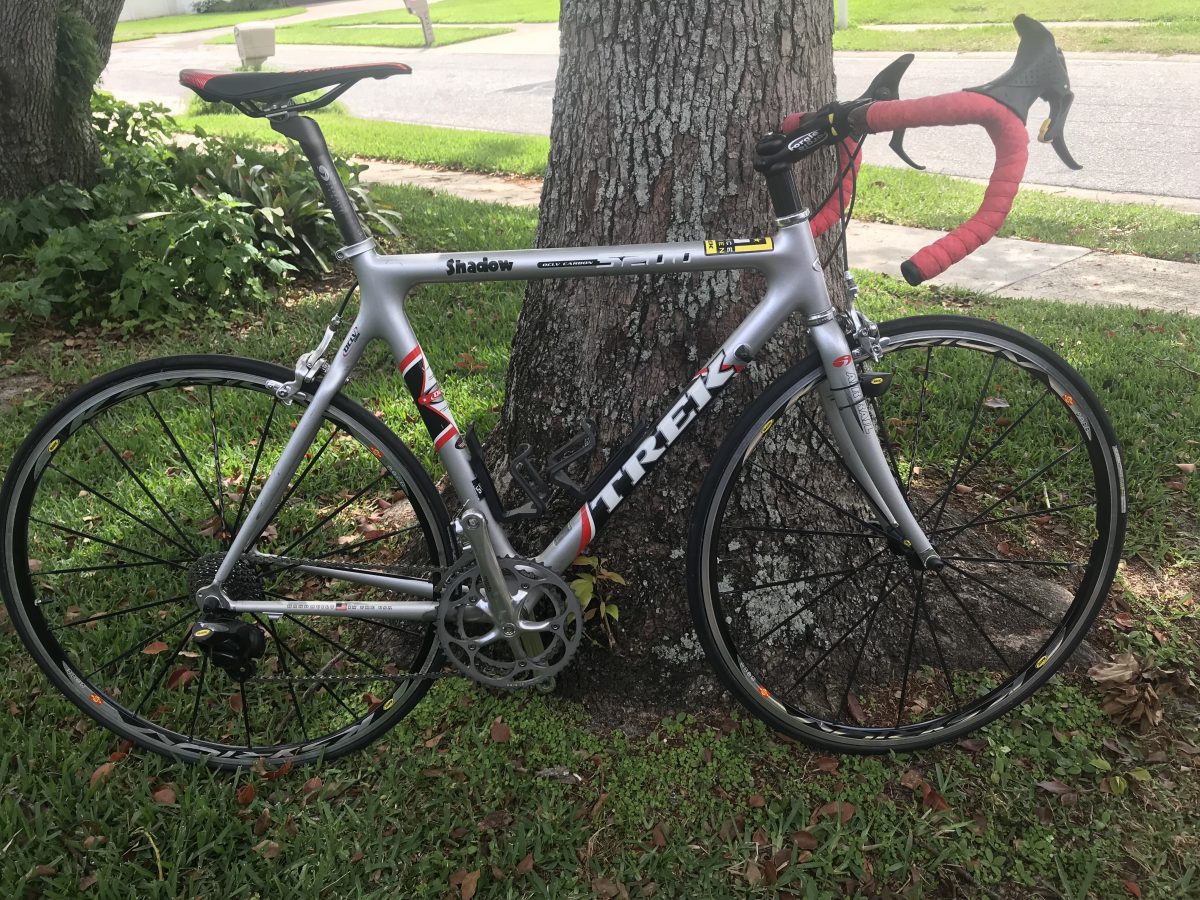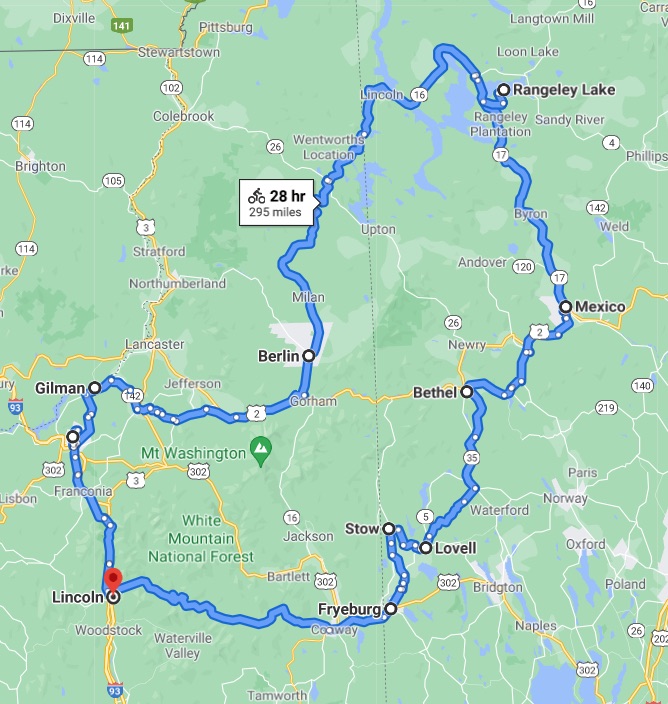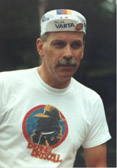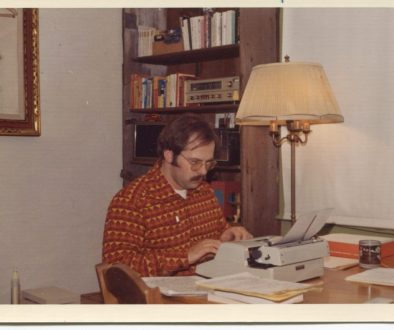“Life on a Bike on the Road”
A Bicycling Odyssey Reminiscence
Because it’s August — not August, 1993, but August, 2021 — it seems like a good enough time to tell the story of my greatest adventure astride a bicycle. This story was originally published in The Ride Magazine by Editor and Publisher Karen Haas, and remains one of my favorite pieces of cycling storytelling. I had some help from two of my Joshua Tree Interactive editors, Kristin Thornburgh and Caitin Park, and I’m grateful to them for getting it into digital format. We three did a lot of serious editing, some to polish it up and some just making corrections, but we didn’t change the narrative at all.
One feature of this blog post we could never have achieved in 1993 is the addition of the Google Maps route map of my ride. As I confess in the story, I never truly knew how many miles I rode; well, now I do and so do you.
One more note: Shadow, the Trek 5500 I rode, was in my bike stable for twenty years. It was one of the early carbon fiber frames and was ridden by Lance Armstrong in his seventh Tour de France win. A year ago, I allowed my friend Peter K. to cajole me out of Shadow with the promise we’d ride together. COVID kind of put the kibosh on that, but we still talk about doing it. We will. More on that in future posts.
I hope you enjoy the read as much as I enjoyed writing it. i’m certain there will be more adventure rides — and tales — in my future.
Life on a Bike on the Road
“I went to the woods because I wished to live deliberately.” – Henry David Thoreau, Walden
Summer, 1992: I went out on the road with my bicycle because I, too, wished to live deliberately. I yearned to discover what kind of stuff I was made of, while forming a stronger rapport with nature. I wanted to go on an extended bicycle tour, by myself, to someplace I’d never been before. Not just a day ride—a real road tour.
I got a whole lot more than I bargained for.
“The mass of men lead lives of quiet desperation,” wrote Thoreau. I told friends and fellow cyclists about my impending adventure and I saw how right he was. Everyone seemed eager to tour for a few days, get away from it all. At first, that was all I had planned for myself. One of my buddies nearly decided to accompany me, but I was uncertain about having a riding companion. Whenever I crossed paths with other riders, I found myself longing for camaraderie, but overall, I enjoyed my solitary time on the road.
At the time I was living in Lincoln, New Hampshire, at the foot of the Kancamagus Pass. I was planning to ride to Rangeley Lake, Maine (which happened to be the termination of the Appalachian Trail) and back, maybe 150 miles each way. I would depart on a Sunday and return by Thursday at the latest. I had a meeting with my publisher Friday in Boston, and fully expected to be back in time for it.
Yeah, right.
Turns out I underestimated my journey’s overall mileage and overestimated my cycling speed. Although I could’ve altered my route, by the second day I didn’t want to. In no time at all I was enjoying this freedom, the riding, the road. I loved everything about the experience and I didn’t want to cut it short just to rush back to work and civilization. So on Tuesday, perched on my bike at a roadside pay phone near the New Hampshire-Maine border, I called my editor and told her we’d have to reschedule the meeting.
I’d run away and joined the circus, so to speak.

Preparation
My first decision was choosing which bike to ride. I had a Bridgestone RB-5 mountain bike and a Specialized Allez racing bike. In the end I took Shadow (I name my bikes), my carbon fiber Allez. I really loved it, but it had no lugs for mounting a rack for panniers, so I had to use a little ingenuity.
I rode a lot to get in shape, naturally, and I worried often about breaking down or having a flat tire—especially since I’d never had one. I spent evenings in my living room, tearing down my tires and tubes to practice. Then, a week before I was to depart, I actually had a flat on the road. It was great! I patched the tube and blew it back up using my mini-pump with great relish, learning in the process that those little pumps aren’t designed to put you back at 100+ pounds of air pressure. So . . .
Tip #1: Carry a CO2 cartridge kit like Superflate. It worked great. I didn’t get a flat again until I was doing a ride out in Oregon later in the year, but the cartridge did more in a few seconds than what my pump might never do.
Tip #2: Join BikeCentennial,* a nonprofit group that supports recreational bike touring with maps, tours, a whole bunch of tour planning services, and a bi-monthly magazine. They provided great advice in “What to Take on Tour,” an article from their The Cyclists Yellow Pages publication. For example, line your panniers with kitchen trash bags so your stuff doesn’t get wet when it rains.
* Now known as Adventure Cycling. I am yet a member.
Without the strength and security of mounting a bike rack with panniers on lugs, I took only the barest minimum of necessities. In addition to a helmet and fingerless gloves, here’s an abbreviated list of what I packed:
2 short-sleeve jerseys, 1 long-sleeve, 2 pair of shorts, 3 pair of socks,
1 T-shirt, 1 pair of off-bike shorts, 1 pair of jeans
Windbreaker, rain suit
Sweatbands, bandana
Clipless cycling shoes, Chinese slippers
Toiletries, including ibuprofen, band-aids, Gold Bond powder, suntan lotion, lip balm
Energy bars, powdered energy drink (OK, OK, PowerBars, Clif Bars and Gatorade!)
Duct tape, cord, sewing kit, bungee cords, flashlight, cable lock
Ziploc plastic bags
Extra brake and derailleur cables
Chain lube
Patch kit, 2 extra tubes (not too paranoid)
Folding toolset, a very small pair of Vise-Grips, Swiss army officer’s pocket knife
Walkman with cassette tapes of radio dramas and Beethoven’s Ninth Symphony
Journaling notebook
Pocket edition of Thoreau’s Walden
Tip #3: The Chinese slippers were a real mistake, since you can’t really do any serious walking in them. I traded ‘em in for some of those aqua slippers.
Tip #4: I wouldn’t take the Walkman again, because even though it was fun listening to old-time radio dramas at night, I was usually so beat that I fell asleep on them. I only used it once while riding, on one long and lonely stretch when I tuned in “Peak FM,” and I will never, ever, listen to that station again as long as I have the strength and will to resist.
One more tip.
Tip #5: I velcroed a microcassette recorder to my handlebar stem so I could take electronic notes while riding. This turned out to be a terrific idea, and I filled an hour’s worth of tape with my ramblings. I had hoped to use the recorder’s voice-actuated circuitry, but quickly discovered the wind turned it on. Just goes to show that technology isn’t always everything it’s cracked up to be.

The Road
Hey, I know, this is the part you’ve being waiting for. Well, herewith my experiences and musings, transcribed (from my recorder) exclusively for readers of “The Ride,” hoping you, too, will embark upon a great cycling tour of your own soon.
Sunday, 11AM: As I pedaled out of Lincoln, a young guy rolled up beside me on a mountain bike. As we rode, we talked about what I was doing and where I was going. He was riding a mile and a half to his job at Loon Mountain. Nice chat; a rather fitting “Bon Voyage.” I was headed east on Highway 112, up a grade of about 13.5 miles and over the Kancamagus Pass at almost 3,000 feet. Figured I might as well do the big climb right off the bat, then the other mountains would seem like a piece of cake by comparison. (Full disclosure: I went out early that morning and did a 15-mile warmup.) It worked; within five or ten miles I got used to the panniers’ additional weight and instability. I cruised right up and over, down the long, mostly downhill 20 miles into North Conway and out 113 to nearby Fryeburg, Maine.
I began tape-recording, fancying myself another William Least Heat Moon, who wrote Blue Highways, a book about traveling the two-lane blacktops of America in a pickup truck. I crashed for the night in a funky cabin, but not before walking a mile back into downtown Fryeberg for a great plate of pasta.
Monday: After some decent pancakes at the same restaurant, I headed north, riding under perfectly blue skies on Route 113. I passed farms, pastures, and meadows, on winding, tree-lined roads with no traffic to speak of. I reached Stow, Maine, little more than a country store at the fork in the road, and here I turned east onto even less-traveled roads and headed toward Lovell and Route 5. The pace was easy, the weather awesome.
Once I get to Lovell, though, the road became a roller coaster ride. I would pedal up a medium-sized hill for a half a mile or so, then coast down the other side. Reaching the bottom, I was obliged to start up another hill. Up, down, ascend, descend, dropping to the lowest gear for the climb, shifting all the way up for the downhill spin. Hill sprints: it wasn’t that they were hard work, just arduous and repetitive. I was so happy to finally have them behind me that I shifted up on the big crank and blew down on the flat road at 22 MPH.
I arrived in Bethel and checked into the Four Seasons Inn, where I had a nice room in a remodeled barn. I had another excellent dinner of fettucine and salad on the sunporch of a restaurant across the street. Afterwards, I strolled the street of Bethel, for indeed there really is only one: it’s touristy, almost artsy-craftsy. I saw a bakery and made a mental note to hit it for breakfast. By eight o’clock it was time for sleep in this quiet li’l town.
Tuesday: Cool, misty, overcast; I donned my long-sleeved jersey. The bakery was no bakery after all but a donut shop, so I gave it a pass. Riding out of town, I figured I’d find breakfast somewhere up the road, and thus made three important discoveries:
- I preferred to work up an appetite by riding 5 to 20 miles before breakfast
- I wanted to become the Duncan Hines of pancakes
- The Lakeside Family Restaurant in Locke Mills, Maine, took first prize for pancakes.
Not only was I served three huge, thick fluffy pancakes cooked golden brown, but they were only $1.95, coffee included. The waitress came back to say the cook had extra batter left over and would I like a few more, no extra charge? But I was stuffed and reluctantly declined.
Yesterday I had ridden fifty miles, and almost sixty the first day out. Since I chose not to carry camping gear, the length of each day’s ride was determined by where I found lodging for the night. Today, I had plans to reach the Rangeley Lakes region of Maine. I wasn’t sure how far it was, but was pretty certain I had a ways to go.
I crossed a river with no current, aptly named the Still River. In Rumford, a man asked if I was from Barcelona. Quizzically, I replied, “No. . . ,” then it dawned on me: I was wearing a jersey with Café de Columbia imprinted on it. I surmised he thought I had been riding in the Tour de France the month before and had taken a wrong turn.
Soon I was in Mexico—Maine, that is—and saw a sign announcing Highway 17, a 32-mile scenic highway, that went up into the Longfellow Mountains. It was great; good pavement, wide shoulders, lots of flat stretches where I could really blast. I told myself, I can easily handle 32 miles of this! My body and senses entered a state of Oneness and united with Shadow. I was The Man and The Machine, the Engine and the Transport, and we kept right on going down the road. My hands were down on the drops, I was cruising along at 18 MPH, and there was very little headwind. My heart monitor said it was pumping at 150, my cadence counter said I was cranking about 90RPMs, and I was loving it all. My thoughts went to how I usually rode to improve my time on a circuit and improve performance. I was almost always in competition with myself, a great way to improve, but sometimes it’s nice to just set a pace and cadence and simply spin the miles away. So that was what I did for an hour or so.
Tip #6: When you’re out on the road all day, you need both short-term and long-term goals. It’s important to get to the next goalpost and reward yourself with a short break or a bite of an energy bar, but you also need to take comfort in knowing that a warm barn awaits you at the end of the day’s ride.
Tip #7: Carry powdered Gatorade in a plastic Ziploc bag. Scoop it into a couple of plastic film canisters to make an energy drink in your water bottle while you’re riding.
Soon I was climbing into the mountains again, some good climbs: long, moderately steep, with no way to gauge when I would reach the summit. It was while riding this stretch that I developed the habit of calling out loud, “Fie! I eat mountains like this for breakfast!”
Eventually I got to a place called Height of Land and stopped to take in the scenery—Mooselookmeguntic Lake and the northern White Mountains—which are beautiful and would be breathtaking were it not for the dense cloud cover. A backpacker and his dog suddenly emerged from the side of the road, climbing the steep incline, and greeted me. He told me this was where the Appalachian Trail crossed Maine Highway 17; there was a hut nearby where he would spend the night. We talked about our individual adventures for a few minutes; he confessed to wishing he rode his bike more. I detected an accent and asked where he was from.
“South Carolina,” he replied. He’d been hiking the trail from his home to here, and had done it three times before! But in utter humility and deference, he said what I was doing was great and he wanted to take my picture to remember our meeting. He handed me his camera and I took his too, him and his dog together on that steep outcrop with the cloud-shrouded mountains behind him. Then I rolled, hoping to reach the Rangeley Lake campground before nightfall.
Wednesday: I laid over for a rest day, but it wasn’t much of a break. Upon arriving, it began raining in earnest—really coming down. I checked into a camp on the lake and got myself a lovely cabin, complete with a kitchen. Venturing out on my bike to the grocery store, still in full rain gear, I managed to cross my chain and locked the drive train up so tight that the bolt holding the derailleur to the rear dropout broke, which wiped out the derailleur, the chain and a few spokes as well.
It was this experience which taught me the definition of an accident: the unanticipated result of an action. Which led to a further Zen-like analysis:
- Based on hindsight being 20/20, how should one have anticipated such an occurrence?
- Did the little voice in one’s head deliver a cautionary warning message that one chose to ignore? If so, then would it still be an accident?
- How should one feel about where the accident happened—e.g. happy it was in a grocery store parking lot and not fifty miles out in the boonies?
- How does one gauge the seriousness of the accident regarding its impact on machine, man, or both?
- Finally, how does one suffer the endless and vicious self-recriminations of “Shoulda, Coulda, Woulda” for what one should have thought to bring along —extra wheel, extra freewheel, extra frame, etc.—in order to restore one’s bicycle to its pre-accident condition? And didn’t?
In the final self-analysis, I decided to blame it on the rain. I would simply get my bike fixed at the local bike shop in the morning.
But I was to learn there was no bicycle shop in Rangeley, this tourist-town where thousands of people gather each year to enjoy the outdoors.
Tip #8: Along with your “in case of accident please notify” phone numbers, carry the toll-free numbers for Bike Nashbar and Performance, and a credit card. That way, you can likely get replacement bike parts by next day air.
Knowing I could accomplish nothing that evening, I fixed dinner and curled up in the warm, dry living room with Thoreau. Come morning, I walked to a nearby restaurant (Duncan Hines says forget the pancakes) where I struck up a conversation with my teenaged waiter to whom I shall ever remain grateful for leading me to one person, then another and yet another who formed a human chain to Brian St. Louis, who fixed my bike. Brian didn’t have a bike shop, but he loved bikes and took the time to help me, although it meant scavenging a derailleur and chain off another bike. Mere money could not repay Brian for the gratitude I felt for him for getting me back on the road.
Tip #9: When you’re on the road, don’t be afraid to network with people. Ask for help if you need it. Just do it.
Thursday: After enjoying a more relaxed second night at my lakeside cabin, I arose the following morning to head west toward New Hampshire and home. I climbed the steep bastard of a hill out of Rangeley, then stopped to leave yet another thank-you note and more money in Brian’s mailbox. The day brought extraordinary vistas as I rode through the mountains, seeing the Presidentials from a northern vantage point for the first time. Then it was south along the Androscoggin River for a long time, a steady headwind in my face.
Tip #10: Listening to Peak FM on a Walkman does in no way help alleviate a headwind.
Tip #11: Add to the mantra, “Fie! I eat mountains like this for breakfast!” this one: “A strong wind in your face builds endurance.”
Friday: I spent the previous evening in the only motel in Berlin, New Hampshire. There was a paper mill in Berlin, so I learned: You do not want to bathe in Berlin. You do not want to drink the water in Berlin. The paper pulp stinks up Berlin. You do not want to stay in Berlin. You are glad you had me to tell you to ride the additional 6 miles or so to Gorham. The pancakes at the restaurant at the junction of Routes 2 and 115 are great.
Over the past few days, I saw some other touring cyclists, all going the opposite way (do they know something I don’t?). We waved at one another (well, one guy didn’t). I waved twice to the pair on the tandem bike; but what I really wanted to do was stop, talk, and compare trip notes. I mean, hey, we’re a special bunch of people and ought to do more than just wave at each other. More like ham radio people, you know?
I had ridden 65-75 miles a day for the past few days, and although I could have made it all the way home today, I decided to (a) cross over into Vermont, so I could claim a tristate tour, and (b) to veg out early at some cool motel with a swimming pool in Littleton. I found a bridge across the Connecticut River and entered Gilman, which I would describe as a ghost town. In my time there, which admittedly was not long, I saw no sign of life. So it was back into the rolling hills of New Hampshire for me, where after a while I stopped at a very kind couple’s home for water refills and a little conversation. Upon arriving in Littleton around mid-afternoon, I found the Maple Leaf Motel, a great place because they did indeed have a pool!
I alternated between jumping in the pool to cool off and sitting in the sun, drying off and reading. I looked up and saw two touring cyclists ride by, bikes laden with full front-and-back packs. About ten minutes later they returned, but this time they pulled in. My wish for companionship had apparently been granted. As one checked in, I struck up a conversation with the other. They were from Montreal, out for a few weeks on the road in New Hampshire and Maine, having ridden south through the mountains, then returning north along the seacoast back home. We hung out for a while that evening.
Saturday: We had breakfast at a diner in Littleton (Duncan Hines says diners are for eggs and bacon, not pancakes). After breakfast and sharing some road lore with my fellow cyclists, I headed south through Franconia, up and out of the valley, and onto the Notch Bike Trail. It was seven miles long and very scenic, except for having to watch out for hikers, naturalists, meandering tourists, other cyclists and small children all darting into your path. I spied a handsome couple climbing on their clean, shiny mountain bikes wearing the requisite Spandex. She wore full makeup. I hoped she wouldn’t sweat too much.
Tip #12: There are some great books on bike touring in New England. Most have names like “25 Bicycle Tours in (choose your state).” They provide a good way to get started, with manageable lengths and clear route maps and directions. Backcountry Publications of Woodstock, Vermont, publishes several good ones.
I arrived home about 1PM. I had ridden about 350* miles. Wish I could have told you exactly how many miles, but sometimes I forgot to switch on the cycle computer. Sometimes life is just like that. I drank a couple quarts of water while sitting out on my sun-drenched deck. Played some tunes, kinda loud. Patted Shadow a few times: thanks for a job well done. I patted myself on the back for spending an awesome, exhilarating week on the road, on a bicycle. As I contemplated my next tour, I opened Walden and read another of Thoreau’s great truths: “Only that day dawns to which we are awake.”
* According to Google Maps, 295 miles. This is a fabulous tool in Google Maps. It created the exact route I took, and calibrated it for a bicycle, hence the length of time, 28 hours (good thing I didn’t have to do it as a marathon).

Jack has written books and ridden bicycles for a long time. His latest novel is about cycling. Its title is Bridge Across the Ocean and it will be published September 14, 2021.




